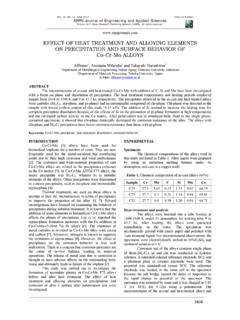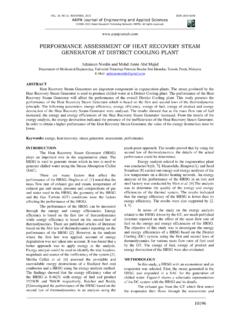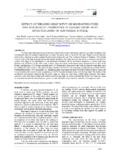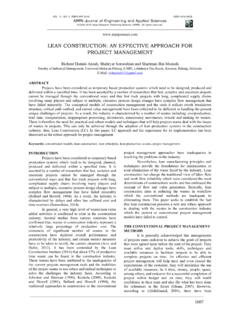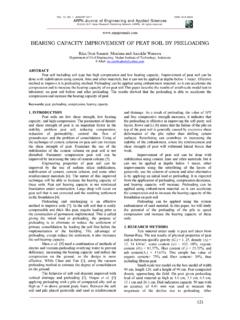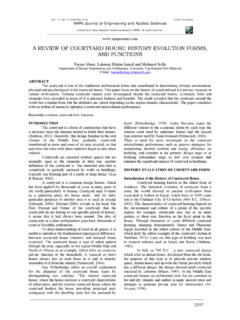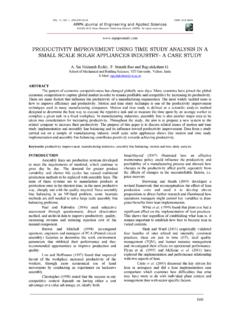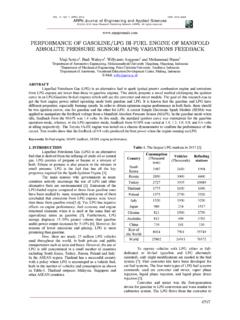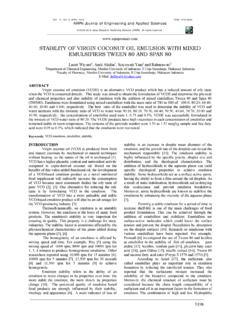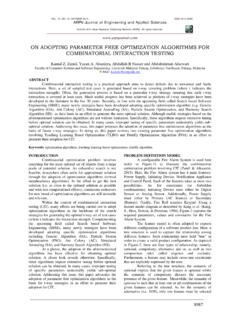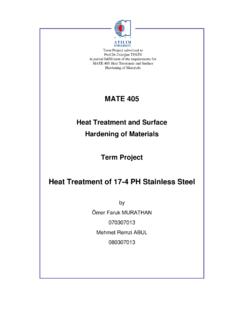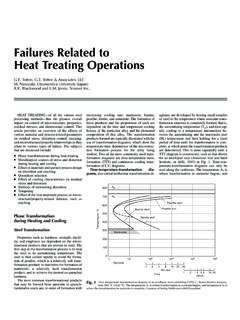Transcription of INFLUENCE OF HEAT INPUT ON CARBON STEEL …
1 VOL. 12, NO. 8, APRIL 2017 ISSN 1819-6608 ARPN Journal of Engineering and Applied Sciences 2006-2017 Asian Research Publishing Network (ARPN). All rights reserved. 2689 INFLUENCE OF heat INPUT ON CARBON STEEL MICROSTRUCTURE Nurul Syahida Mohd Nasir, Mohammad Khairul Azhar Abdul Razab, Muhammad Iqbal Ahmad and Sarizam Mamat Advanced Materials Research Cluster, Faculty of Earth Science, Universiti Malaysia Kelantan, Jeli, Kelantan, Malaysia E-Mail: ABSTRACT Low heat INPUT is the most common welding parameters selected in industries application due to its ability to produce refined microstructure, less stress and distortion of weldment. However, low heat INPUT has limit penetration and can result in weaken the weldment joint.
2 Recently, high heat INPUT parameter is widely used in shipping industry where it provide deeper penetration. However, high heat INPUT can cause coarse microstructure and decrease weldment toughness which lead to greater amount of distortions. Due to this issue, it is important to know the real effects of applied heat INPUT to the STEEL microstructure. In this study, two types of CARBON steels undergo gas metal arc welding (GMAW) process were investigated to find the effects of low, medium and high heat INPUT on STEEL microstructures, respectively. From this study, the results revealed that heat INPUT parameters were effect the CARBON STEEL at heat affected zone (HAZ) size, coarse grain heat affected zone (CGHAZ) area and fusion line (FL) length. Keywords: CARBON STEEL , microstructure, coarse grain heat affected zone, fusion line. INTRODUCTION STEEL is an Iron- CARBON (Fe-C) alloys usually contained less than wt. % CARBON and widely used in material industries due to its low cost, good mechanical strength, abundance source, high melting temperature, and variety mechanical properties [1-3].
3 There are several types of STEEL such as CARBON STEEL , stainless STEEL , alloyed STEEL and tool STEEL . CARBON STEEL is commonly used for shipping and automotive industries. Usually, this STEEL undergoes welding process with different heat INPUT to form necessaries part. heat INPUT is a relative measure of the energy transferred per unit length of weld. heat INPUT is one of the crucial parameter that has to be concerned during welding procedure specification (WPS) preparations. heat INPUT values will be the determinants for decision of post weld heat treatment (PWHT). The values also INFLUENCE cooling rate which is the primary factors to determine the final metallurgical structure of the weld and heat Affected Zone (HAZ). heat INPUT also one of the factors in determining HAZ grain size and width [4]. Moreover, these welding parameters also act as the main factors in affecting the embrittlement of weld joints [17].
4 Microstructures play significant effects on STEEL strength and toughness[5-6]. From literatures, few studies of microstructures have been done on HAZ, but the specific study on Coarse Grain heat Affected Zone (CGHAZ) and fusion line (FL) are not well documented. Hence, the main focus of this research is to identify the effects of welding heat INPUT parameters (low, medium and high) on the certain numbers of low and high CARBON steels microstructures especially in CGHAZ and FL of CARBON STEEL regions. MATERIALS AND METHODS Samples preparation In this study, six (three low CARBON and three high CARBON STEEL ) samples with dimensions of with 6 mm x 200 mm x 125 mm were provided. Table-1 shows the STEEL chemical compositions for both low and high CARBON STEEL . The sample undergoes Gas Metal Arc Welding (GMAW) process with three different welding parameters as shown in Table-3. Filler material was used to join the welds and chemical composition for the electrodes presented in Table-2.
5 The samples were then cut into 6 mm x 5 mm x 15 mm as shown in Figure-1. Figure-1. CARBON STEEL sample. Table-1. Chemical composition. Mill certificate Chemical composition, % C Si Mn P S Cu Ni Cr Mo ABS Grade A S50C - VOL. 12, NO. 8, APRIL 2017 ISSN 1819-6608 ARPN Journal of Engineering and Applied Sciences 2006-2017 Asian Research Publishing Network (ARPN). All rights reserved. 2690 Table-2. Chemical composition of filler material. Wire designation Wire dimension (mm) Chemical composition (%) Tensile strength (N/mm2) C Si Mn P S K-71T 580 Table-3.
6 Welding parameters. Sample designation Welding current (A) Voltage (V) Welding speed (mm/sec) heat INPUT (kJ/mm) A 135 22 180 B 166 22 180 C 196 23 120 Microscopic study Microscopic study for both low and high CARBON steels were carried out in analyzing their microstructures characteristics. STEEL surfaces were grounded and polished with silicon carbide (SiC) and diamond abrasive papers into mirror surface using Metkon Forcipol 2V Grinder Polisher machine. The steels were then etching using 2% Nital solution containing 2ml Nitric Acid (HNO3) and 98ml ethanol (C2H5OH). Nital solution was used to highlighted weld, base, and heat Affected Zone (HAZ) for more visibility. In this analysis, Metallurgical Microscope (MT8100) with an inbuilt camera (Digital Microscope Camera ProgRes CT3) as shown in Figure-2(a) was used to observe STEEL microstructures. The STEEL microstructures were captured and measured using ProgRes CapturePro Camera Control Software version as shown in Figure-2(b).
7 The biggest grain at CGHAZ were then chosen and captured for region of interest (ROI) area measurements. Fusion line (FL) was determine by choosing and captured the widest line before determine its width. Figure-2(a). Metallurgical microscope (MT8100) and (b). ProgRes CapturePro software. RESULTS AND DISCUSSIONS Welding STEEL microstructure Welding involves heating process that jointwo base metal (BM) together to form into a single component. During the welding process, weld area will be heated up rapidly until melting point and followed by rapid cooling which effect the weld metal microstructures and properties. Meanwhile, BM area was unaffected due to its ROIis relatively far from the heat source. As results, its microstructure and properties are same before and after the welding process. Hence, there will be two main areas after the welding process which are the unaffected area of BM and affected area of weld metal (WM) as shown in Figure-3.
8 Weld area can be defined as an area that comprises of weld metal (WM), fusion line (FL) and heat affected zone (HAZ). VOL. 12, NO. 8, APRIL 2017 ISSN 1819-6608 ARPN Journal of Engineering and Applied Sciences 2006-2017 Asian Research Publishing Network (ARPN). All rights reserved. 2691 Figure-3. Welding STEEL component. During welding process, weld area was heated up rapidly until melting point and followed by rapid cooling. Rapid heating and cooling process will cause microstructural and property alterations, where recrystallization and grain growth of HAZ leads weaken sections and favorable cracking parts at the weldment. HAZ is a part of BM adjacent to the weld which has not been melted, but the mechanical properties or microstructure was altered by heat .
9 The change in HAZ microstructure was depends on the welding parameters and the rate of cooling process. In this case, heat INPUT is one of the parameter in determining the cooling rate as define using the following function [7]: (1) where R = cooling rate, To= preheat temperature and Q = heat INPUT . From the equation, as heat INPUT increase, the cooling rate will decrease. This situation directly expresses the major role of heat INPUT parameters in determining HAZ microstructure. heat INPUT can be calculated by using following equation: (2) where Q = heat INPUT (kJ/mm), I = Current (A), V = Voltage (V) and S = Welding speed (mm/s). Normally, as heat INPUT increased, HAZ of the joints was increased proportionally. This is because the heat INPUT was moving further in HAZ from the fusion line [8].
10 Figures-4-6 shows the microstructures of Base Metal (BM), heat Affected Zone (HAZ), Fusion Line (FL) and Weld Metal (WM) of low CARBON STEEL . Based on the figures, STEEL with low heat INPUT obtained less coarse HAZ microstructures while the STEEL with high heat INPUT obtained coarser microstructures than others. Figure-4. Optical micrograph for low heat INPUT of low CARBON STEEL . Figure-5. Optical micrograph for medium heat INPUT of low CARBON STEEL . Figure-6. Optical micrograph for high heat INPUT of low CARBON STEEL . Meanwhile, Figures-7-9 has shown the microstructures of BM, HAZ, FL, and WM of high CARBON STEEL . Based on the figures, STEEL with low heat INPUT obtained less coarse HAZ microstructures while the STEEL with high heat INPUT obtained more coarse microstructures than others. Basically high heat inputs cause coarsening of microstructures in HAZ [9], because of that both STEEL (low and high CARBON STEEL ) that undergo high heat INPUT had coarsed microstructure than others heat INPUT .
